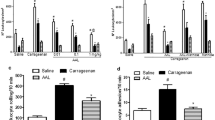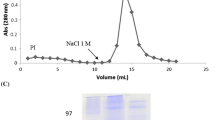Abstract
Intravenous injection of arabinogalactan or dextran together with pontamine sky-blue dye into mice increased vascular permeability and led to marked blueing of the ears. Arabinogalactan caused a rapidly progressing ear blueing (maximal coloration 20–30 min after injection). This response was suppressed by pretreating the animals with the histamine H1-antihistamines levocabastine and loratadine. In contrast, dextran induced a slowly evolving ear inflammation (maximal coloration 60–90 min after injection), which was blocked by the 5-HT-serotonin antagonists cinanserin, metergoline and ritanserin. Furthermore, the dextran reaction was inhibited by the lipoxygenase (LO)/cyclooxygenase (CO) inhibitors BW540C, BW755C and phenidone and by the specific 5-LO inhibitor AA-861. Both arabinogalactan and dextran responses were inhibited by aprotinin, a kallikrein inhibitor, and the mixed H1/5-HT antagonists astemizole and azatadine. The inflammogenic activity of the polysaccharides was not affected by administration of the CO inhibitors indomethacin and suprofen, the thromboxane synthetase inhibitor dazoxiben, the H2-antihistamines cimetidine and ranitidine, the anticholinergics isopropamide or the PAF-antagonist L-652,731.
These data indicate the existence of distinctive endogenous molecules that mediate the pinnal extravasation reaction to both polysaccharides: histamine for arabinogalactan, serotonin and lipoxygenase-derived arachidonic acid metabolites for dextran.
Similar content being viewed by others
References
R. Anderson and E. Hardenbergh,Anaphylactoid reaction of the mouse to dextran. Proc. Soc. exp. Biol. Med.117, 565–567 (1964).
W. Richter,Increased vascular permeability in mice induced by dextran. A comparison with the anaphylactoid reaction in rats. Acta pharmac. tox.27, 331–348 (1969).
L. S. Kind, B. Macedo-Sobrinho and D. Ako,Enhanced vascular permeability incuded in mice by larch arabinogalactan. Immunology19, 799–807 (1970).
S. I. Ankier and M. L. Neat,Some studies on acute inflammation by dextran in the mouse. Int. Archs. Allergy42, 264–277 (1972).
J. P. van Wauwe and J. G. Goossens,Dextran-induced edema formation in mouse ear: a pharmacological evaluation. Drug Dev. Res.8, 213–218 (1986).
R. A. Stokbroeckx, M. G. Luyckx, J. J. Willems, J. O. Bracke, R. Joossen and J. P. van Wauwe,Levocabastine (R 50 547): the prototype of a chemical series of compounds with specific H 1-antihistaminic activity. Drug Dev. Res.8, 87–93 (1986).
S. I. Ankier and M. L. Whiteside,A simple procedure for the quantitative extraction of extravasated dye in skin tissue. Biochem. Pharmac.18, 2197–2202 (1969).
D. J. Finney, Cambridge University Press, pp. 236–254 (1962).
A. Barnett, L. C. Iorio, W. Kreutner, S. Tozzi, H. S. Ahn and A. Gulbenkian,Evaluation of the CNS properties of SCH 29851, a potential non-sedating antihistamine. Agents and Actions14, 590–597 (1984).
J. E. Leysen, C. J. E. Niemegeers, J. P. Tollenaere and P. M. Laduron,Serotoninergic component of neuroleptic receptors. Nature272, 168–171 (1978).
M. Hamon, M. Mallat, A. Herbet, D. L. Nelson, M. Audinot, L. Pichat and J. Glowinski, [3H]Metergoline: a new ligand of serotonin receptors in the rat brain. J. Neurochem.36, 613–626 (1981).
J. E. Leysen, W. Gommeren, P. van Gompel, J. Wijnants, P. F. M. Janssen and P. M. Laduron,Receptor binding properties in vitro and in vivo of ritanserin. A very potent and long acting serotonin-S 2 antagonist. Mol. Pharmacol.27, 600–611 (1985).
F. C. Copp, P. J. Islip and J. E. Tateson,3-N-substituted-amino-1-[3-(trifluoromethyl)phenyl]-2-pyrazolines have enhanced activity against arachidonate 5-lipoxygenase and cyclooxygenase. Biochem. Pharmac.33, 339–340 (1984).
G. A. Higgs, R. J. Flower and J. R. Vane,A new approach to anti-inflammatory drugs. Biochem. Pharmac.28, 1959–1961 (1979).
G. J. Blackwell and R. J. Flower,1-Phenyl-3-pyrazolidone: an inhibitor of cyclo-oxygenase and lipoxygenase pathways in lung and platelets. Prostaglandins16, 417–425 (1978).
Y. Ashida, T. Saijo, H. Kuriki, H. Makino, S. Terao and Y. Maki,Pharmacological profile of AA-861, a 5-lipoxygenase inhibitor. Prostaglandins26, 955–970 (1983).
R. Vogel,Kallikrein inhibitors. InHandbook of Experimental Pharmacology, vol. 25. (Ed. E. G. Erdös) pp. 165–399, Springer-Verlag, New York 1979.
T. J. Williams,Vascular responses and their suppression: vasodilatation and oedema. InThe Pharmacology of Inflammation, vol. 5. (Eds. I. L. Bonta, M. A. Bray, M. J. Parnham) pp. 49–60, Elsevier, Amsterdam 1985.
D. Regoli and J. Barabe,Pharmacology of bradykinin and related kinins. Pharmac. Res.32, 1–46 (1980).
D. A. Owen,Vascular changes during acute inflammatory responses in rat hindpaws. InPerspectives in Inflammation. (Eds. D. A. Willoughby, J. P. Giroud, G. P. Velo) pp. 491–495, MTP, London 1977.
D. A. Owen and D. F. Woodward,Histamine and histamine H 1- and H2-receptor antagonists in acute inflammation. Biochem. Soc. Trans.8, 150–156 (1980).
W. G. Spector and D. A. Willoughby,Vasoactive amines in acute inflammation. Ann. N.Y. Acad. Sci.116, 839–846 (1964).
H. Bisgaard, J. Kristensen and J. Sondergaard,The effect of leukotriene C 4 and D4 on cutaneous blood flow in humans. Prostaglandins23, 797–801 (1982).
N. A. Soter, R. A. Lewis, E. J. Corey and K. F. Austen,Local effects of synthetic leukotrienes (LTC 4, LTD4, LTE4 and LTB4)in human skin. J. invest. Derm.80, 115–119 (1983).
A. Veno, K. Tanaka, M. Katori, M. Hayashi and Y. Arai,Species difference in increased vascular permeability by synthetic leukotriene C 4 and D4. Prostaglandins21, 637–647 (1981).
M. J. Peck, P. J. Piper and T. J. Williams,The effect of leukotrienes C 4 and D4 on the microvasculature of guinea pig skin. Prostaglandins21, 315–321 (1981).
Author information
Authors and Affiliations
Rights and permissions
About this article
Cite this article
van Wauwe, J.P., Goossens, J.G. Arabinogalactan- and dextran-induced ear inflammation in mice: Differential inhibition by H1-antihistamines, 5-HT-serotonin antagonists and lipoxygenase blockers. Agents and Actions 28, 78–82 (1989). https://doi.org/10.1007/BF02022984
Received:
Accepted:
Issue Date:
DOI: https://doi.org/10.1007/BF02022984




